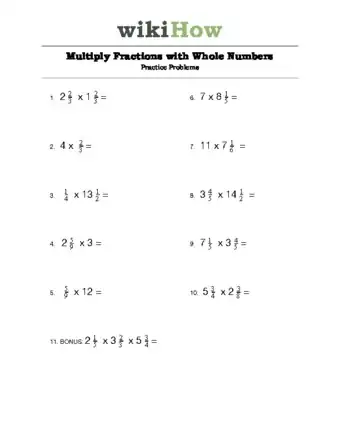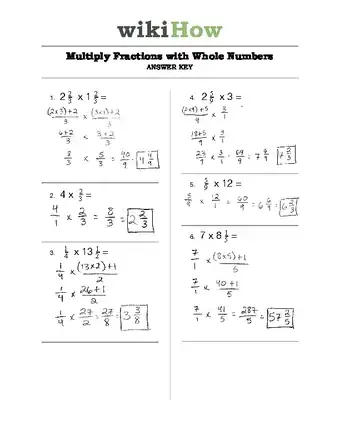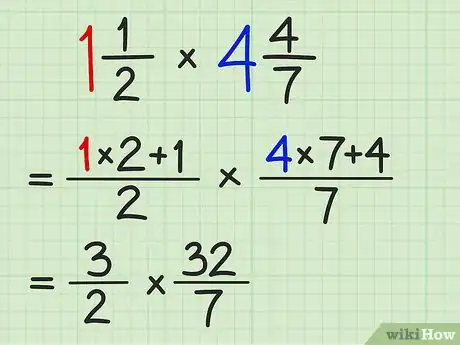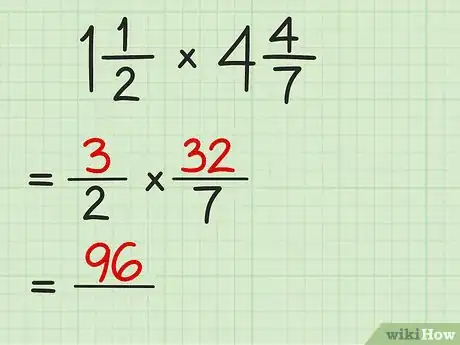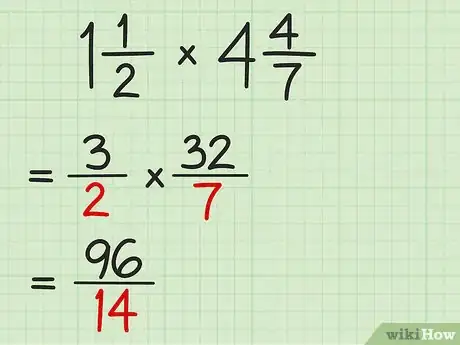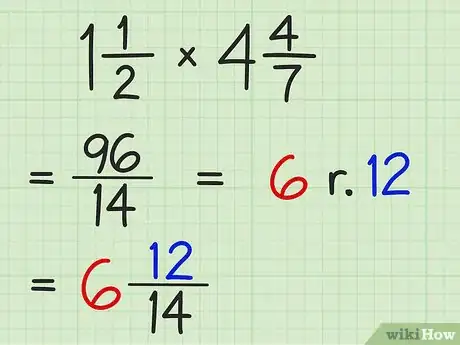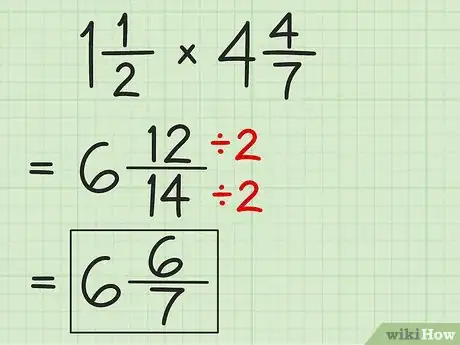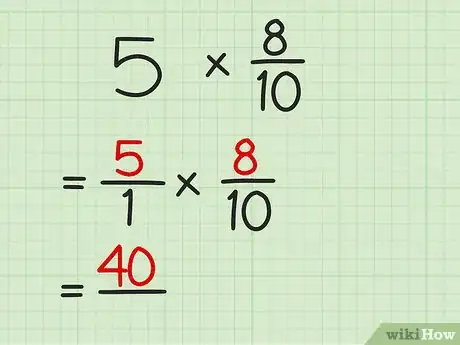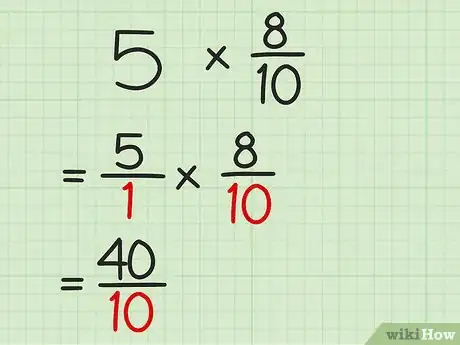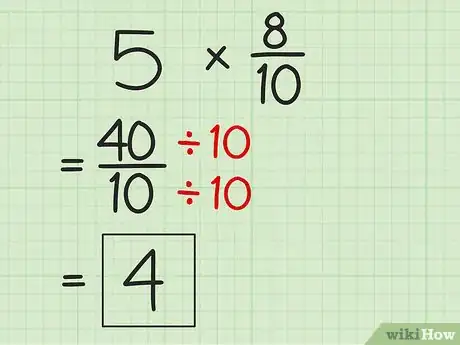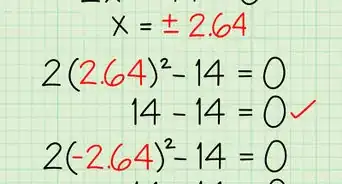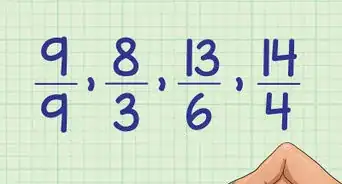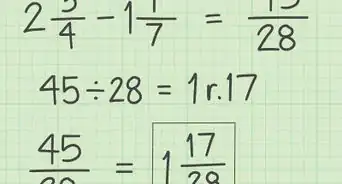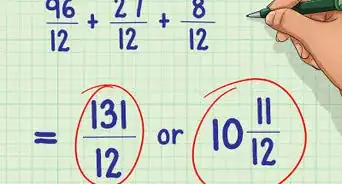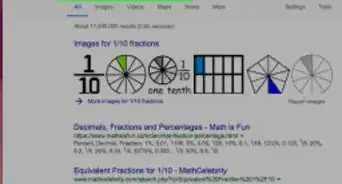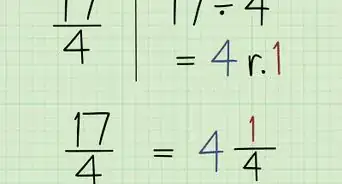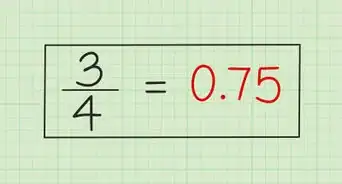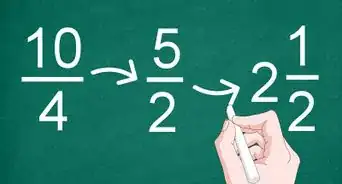This article was co-authored by Mario Banuelos, PhD and by wikiHow staff writer, Jessica Gibson. Mario Banuelos is an Assistant Professor of Mathematics at California State University, Fresno. With over eight years of teaching experience, Mario specializes in mathematical biology, optimization, statistical models for genome evolution, and data science. Mario holds a BA in Mathematics from California State University, Fresno, and a Ph.D. in Applied Mathematics from the University of California, Merced. Mario has taught at both the high school and collegiate levels.
This article has been viewed 2,151,741 times.
It's easy to multiply fractions by mixed fractions or whole numbers. Start by turning your mixed fractions or whole numbers into improper fractions. Then multiply the numerators of both improper fractions. Multiply the denominators and simplify your result.
Steps
Practice Problems
Multiplying Mixed Fractions by Mixed Fractions
-
1Convert the mixed fractions to improper fractions. To change 1 of the mixed fractions, multiply the denominator by the whole number. Then add the numerator. Place the result over the line and leave the denominator as-is. Repeat this for the other mixed fraction.[1]
- For example, if you start with 1 1/2 x 4 4/7, change them to improper fractions. 1 1/2 will become 3/2 and 4 4/7 will become 32/7. Your equation will now by 3/2 x 32/7.
-
2Multiply the numerators of the improper fractions. Now that you have 2 improper fractions and no whole numbers in the equation, multiply the numerators together. Write the result and place a line below it.[2]
- The numerator is always the top number in a fraction.
- For example, with 3/2 x 32/7, multiply 3 by 32 to get 96.
Advertisement -
3Multiply the denominators of the improper fractions. Multiply the numbers below the line and write the result under your numerator.[3]
- For example, with 3/2 x 32/7, multiply the 2 by 7 to get 14.
-
4Turn the answer into a mixed fraction if possible. If the numerator of your result is larger than the denominator, see how many times the denominator will go into the numerator. Then leave put the remainder over the denominator to give you a mixed fraction.[4]
- For example, if you got 96/14, see how many times 14 will go into 96. You'll get 6 with 12 left over. Place 12 over the denominator (14).
- Most instructors will want you to put the answer in the same form as the question. So if you started with mixed fractions, convert your answer to a mixed fraction.
-
5
Multiplying Fractions by Whole Numbers
-
1Rewrite the whole number as a fraction.[6] To rewrite a whole number as a fraction, simply place the whole number over 1. This will make an improper fraction.[7]
- For example, if you have 5 x 8/10, put the 5 over 1. You should now have 5/1 x 8/10.
-
2
-
3Multiply the denominators of the two fractions.[10] Now you can multiply the numbers below the lines to get your denominator. You should now have an answer to your equation that's in fraction form.[11]
- For example, if you're multiplying 5/1 x 8/10, multiply 1 by 10 to get 10. Place this below the line to get an answer of 40/10.
-
4Reduce the answer if possible. Because your answer will probably be an improper fraction, simplify the answer to its lowest terms. Divide the numerator by the denominator to get a simplified result.[12]
- To reduce 40/10, divide 40 by 10 to get 4 as your new answer.
- In many cases, you'll get a mixed number since the answer will have a remainder.
Community Q&A
-
QuestionWhat if the question has two fractions, like 1/4 x 13 1/2?
 DonaganTop AnswererChange the mixed number to an improper fraction, then multiply numerator by numerator and denominator by denominator. Simplify the answer if possible, and change it back to a mixed number if you like.
DonaganTop AnswererChange the mixed number to an improper fraction, then multiply numerator by numerator and denominator by denominator. Simplify the answer if possible, and change it back to a mixed number if you like. -
QuestionPlease give an example of multiplying fractions and whole numbers.
 Community AnswerIf you have a question of say, 4 x 2/3, take the 4 first, and put it out of 1, making it 4/1. The reason is that it's 4 wholes. To check, you can simplify 4/1, which will be 4, so it's obviously right.Then, taking 4/1 x 2/3, multiply the numerators first. The numerators, which are 4 and 2, will be multiplied to make 8. Question so far: 4/1 x 2/3= 8/? To find the denominator of the answer, take the denominators of the question, 1 and 3, and multiply those together. 1 multiplied by 3 will be 3. Question Answered: 4/1 x 2/3= 8/3. So, your answer is 8/3, and there you have it.
Community AnswerIf you have a question of say, 4 x 2/3, take the 4 first, and put it out of 1, making it 4/1. The reason is that it's 4 wholes. To check, you can simplify 4/1, which will be 4, so it's obviously right.Then, taking 4/1 x 2/3, multiply the numerators first. The numerators, which are 4 and 2, will be multiplied to make 8. Question so far: 4/1 x 2/3= 8/? To find the denominator of the answer, take the denominators of the question, 1 and 3, and multiply those together. 1 multiplied by 3 will be 3. Question Answered: 4/1 x 2/3= 8/3. So, your answer is 8/3, and there you have it. -
QuestionHow do I work 1/5×7?
 SnallisonCommunity AnswerFirst, you make 7 into a fraction by putting it over 1, to create 7/1. Then you multiply across the top and across the bottom, which gives you 7/5. Because this is improper, you have to make this into a mixed number. To fix this, you have to divide 7 by 5. The answer is 1 with a remainder of 2. 1 is the whole number and 2 goes over the original denominator, 5. The final answer is 1 2/5.
SnallisonCommunity AnswerFirst, you make 7 into a fraction by putting it over 1, to create 7/1. Then you multiply across the top and across the bottom, which gives you 7/5. Because this is improper, you have to make this into a mixed number. To fix this, you have to divide 7 by 5. The answer is 1 with a remainder of 2. 1 is the whole number and 2 goes over the original denominator, 5. The final answer is 1 2/5.
References
- ↑ https://www.mathsisfun.com/mixed-fractions-multiply.html
- ↑ https://www.georgebrown.ca/uploadedFiles/TLC/_documents/Multiplying%20and%20Dividing%20Fractions.pdf
- ↑ https://www.georgebrown.ca/uploadedFiles/TLC/_documents/Multiplying%20and%20Dividing%20Fractions.pdf
- ↑ https://www.georgebrown.ca/uploadedFiles/TLC/_documents/Multiplying%20and%20Dividing%20Fractions.pdf
- ↑ https://www.georgebrown.ca/uploadedFiles/TLC/_documents/Multiplying%20and%20Dividing%20Fractions.pdf
- ↑ Mario Banuelos, PhD. Assistant Professor of Mathematics. Expert Interview. 11 December 2022.
- ↑ https://www.mathsisfun.com/fractions_multiplication.html
- ↑ Mario Banuelos, PhD. Assistant Professor of Mathematics. Expert Interview. 11 December 2022.
- ↑ https://www.cuemath.com/numbers/multiplying-fractions-with-whole-numbers/
- ↑ Mario Banuelos, PhD. Assistant Professor of Mathematics. Expert Interview. 11 December 2022.
- ↑ https://www.cuemath.com/numbers/multiplying-fractions-with-whole-numbers/
- ↑ https://flexbooks.ck12.org/cbook/ck-12-middle-school-math-concepts-grade-6/section/7.1/primary/lesson/multiplication-of-fractions-and-whole-numbers-msm6/
About This Article
To multiply a fraction by a whole number, first rewrite the whole number as a fraction by putting it over a 1. For example, let’s say you’re trying to solve 5 x 8/10. You would start by rewriting 5 as a fraction. Now the equation looks like 5/1 x 8/10. Next you need to multiply the numerators, or top numbers, of the fractions together. In our example, 5 and 8 are the numerators, so you would multiply 5 by 8 and get 40. Now do the same thing with the denominators, or bottom numbers, of the fractions. One and 10 are the denominators, so you would multiply 1 by 10 and get 10. The new fraction is 40/10. If you can’t simplify the new fraction, you’re done and that’s your answer. If you can, simplify the fraction to the lowest terms. In our example we ended up with 40/10, which can be simplified by dividing the numerator and denominator by 10, which gives you 4/1. Therefore, 5 x 8/10 = 4/1, or 4. To learn how to multiply a normal fraction with a whole number, scroll down!
